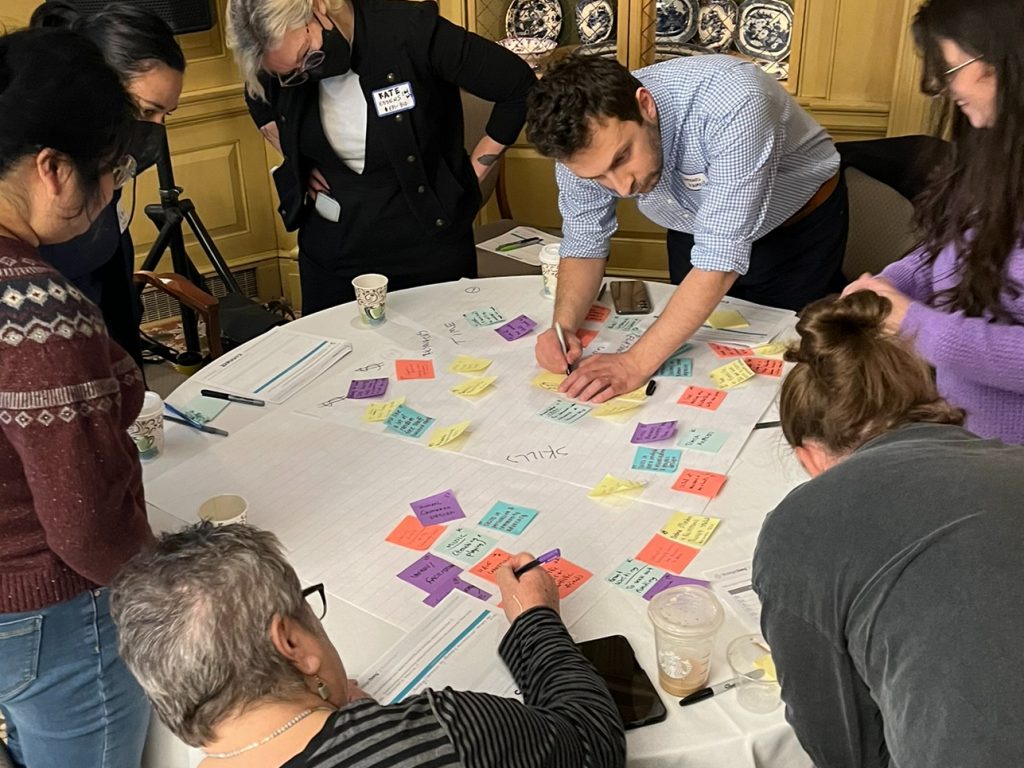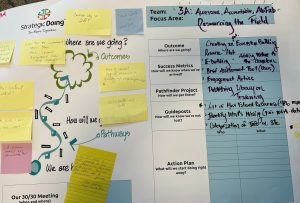Strategic Doing: Overcoming Analysis Paralysis
We’ve all been there—stuck in endless brainstorming sessions, debating possibilities, and never quite reaching a decision. Ideas abound but progress stalls. This “analysis paralysis” can cripple even the most well-intentioned teams. But there’s a way to break free and propel forward: Strategic Doing.
The Trap of Analysis Paralysis
Analysis paralysis occurs when overthinking and excessive deliberation prevent decision-making. In traditional brainstorming, teams often generate an overwhelming number of ideas, each with its own set of pros and cons. The sheer volume of options can be paralyzing, leading to indecision and inaction. Instead of moving forward, teams get bogged down by endless debates and risk assessments.

A small group considers “What COULD we do?” on their way to creating strategic opportunities and a short term action plan.
Strategic Doing: A Path to Action
Strategic Doing offers a structured approach to overcome this inertia. We ideate on what’s possible in our “What Could We Do?” phase, but we do so within clear parameters: we use a framing question to guide our conversation and we consider what’s possible based on the assets held in the group. We limit our time in this ideation phase and, importantly, move swiftly to action.
Here’s how Strategic Doing helps teams transition from ideation to implementation:
Focus on Quick Wins:
- Strategic Doing emphasizes identifying and acting on “quick wins”—small, achievable actions that can be completed in a short time frame. These action steps build momentum and demonstrate progress, making larger strategic objectives feel more attainable.
Set Clear and Measurable Outcomes:
- Rather than getting lost in a sea of possibilities, Strategic Doing encourages teams to prioritize actions based on their potential impact and feasibility. This focused approach helps cut through the noise and directs energy toward the most promising initiatives.
Collaborative Micro-commitments:
- In Strategic Doing, collaboration is key. Teams make explicit commitments to take specific actions, fostering accountability. This collective responsibility to make small, time-bound actions (micro-commitments can be as little as one hour per month) ensures that tasks don’t just linger as ideas but translate into real, tangible outcomes.
Iterative Progress:
- Strategic Doing involves a series of small experiments. It recognizes that not every action will be perfect or lead to immediate success. Through continuous iteration of assessing and refining strategies, teams can adapt and pivot, learn from each step and steadily move closer to their goals.
Take the Leap

Moving swiftly to “What WILL we do?” creates momentum and allows teams to experiment.
To break free from analysis paralysis, it’s crucial to take the action step to move to “What will we do?” By adopting the skills of Strategic Doing, teams can overcome the inertia of indecision and start taking meaningful steps toward their objectives.
As Lao Tzu wrote, “the journey of a thousand miles begins with a single step.” In Strategic Doing, that first step is about action—small, deliberate, and purposeful. Let’s move from pondering possibilities to creating realities where our focus is on achievable progress and not an idealized state of perfection. Life is messy–let’s roll up our sleeves and dig in!